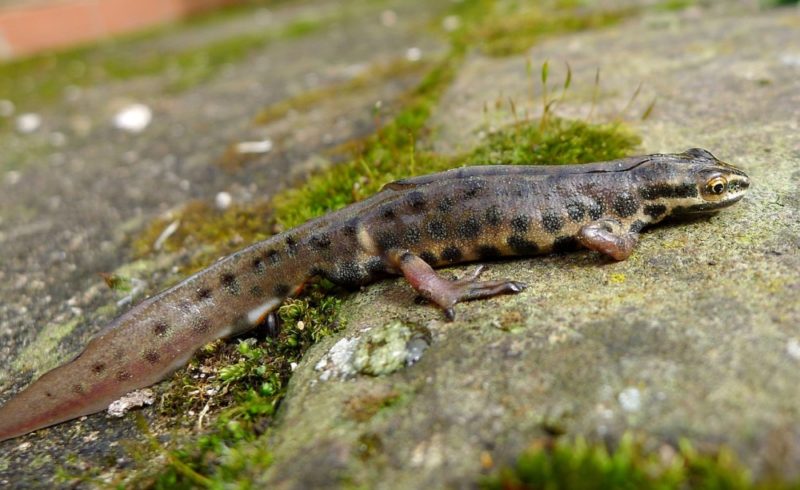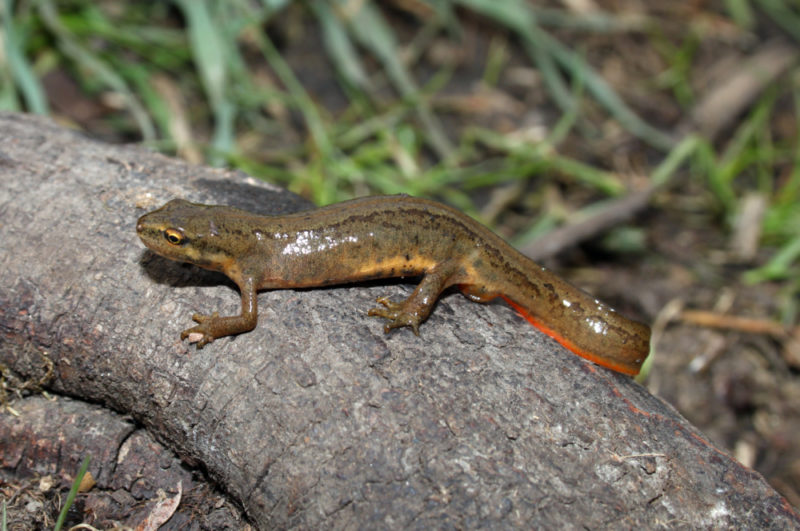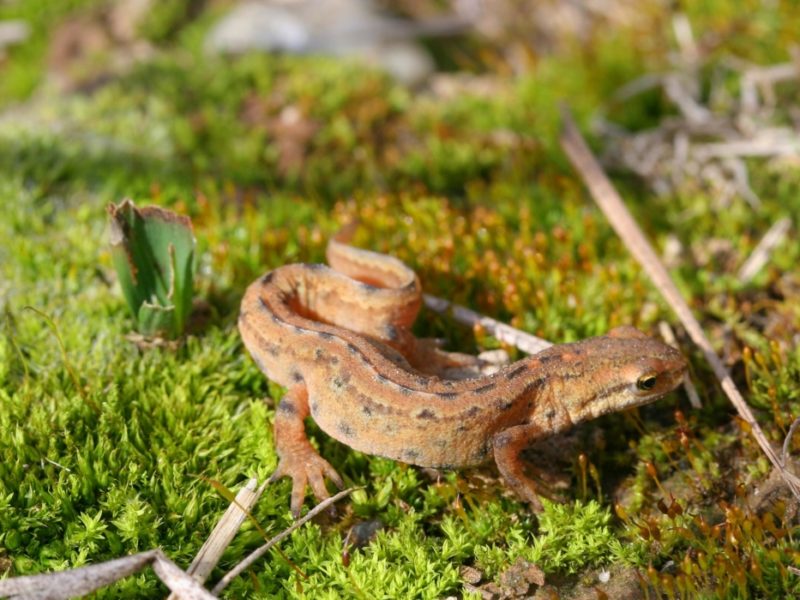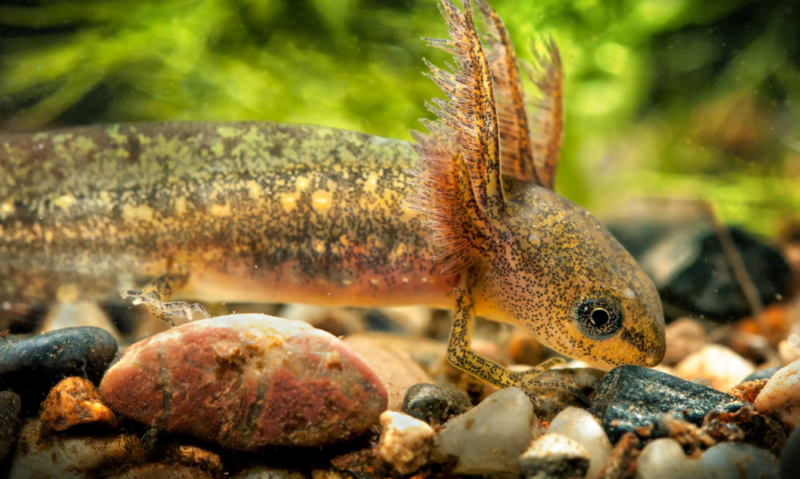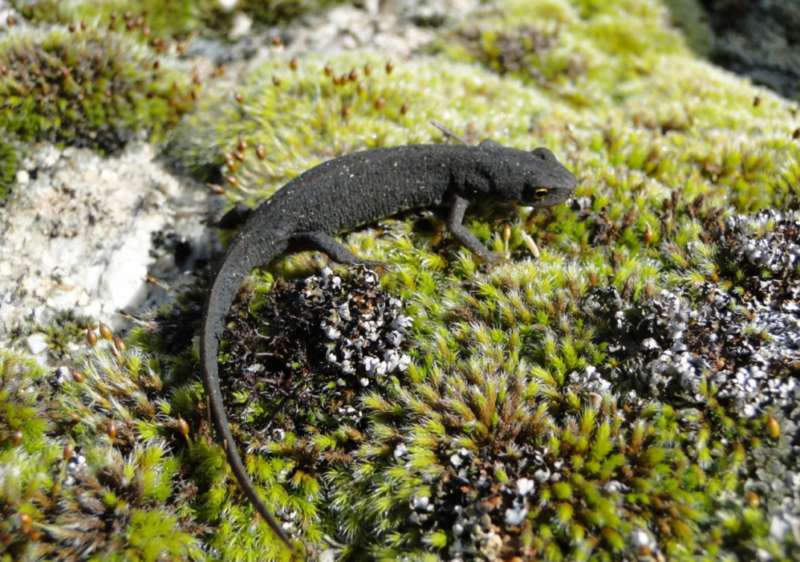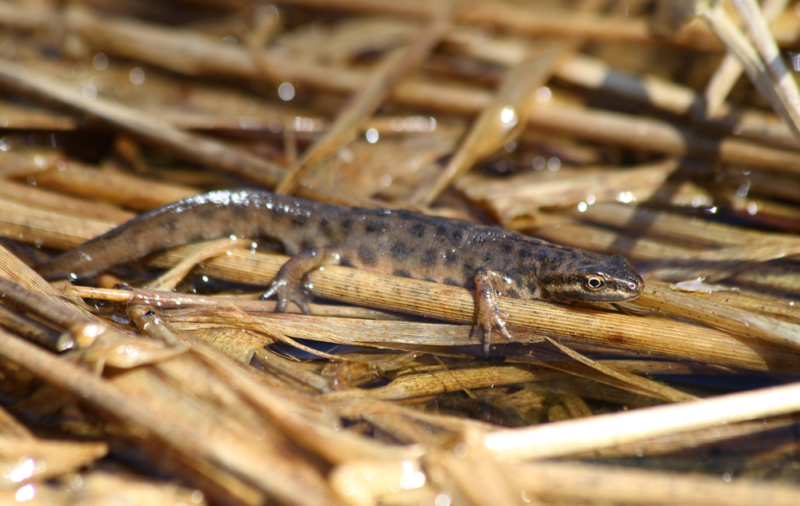Common Triton is the smallest representative of its kind. Adult animals reach 12 cm, with half the length of the tail. These are unpretentious and non-capricious creatures that appeal to beginner and experienced aquarists.
Material Content:
Description and features of the species
There are 9 subspecies of newts, some are listed in the International Red Book.
Description of the species: ordinary newt is covered with smooth fine-grained skin, pleasant to the touch. Distinguishes between yellow, blue-green and red. The opener teeth are parallel, converge slightly behind. Longitudinal dark stripes pass at eye level. The length of the tail is equal to the length of the body. Shed every 7 days. Males have spotty coloring that distinguishes them from females.
In males, with the onset of the mating season, a crest grows along the entire back, which serves as an additional respiratory organ. There are many capillaries in it, which improves skin respiration. The crest is whole, with bends in the upper part, and an orange rim and a blue stripe pass along the lower. In females, the crests do not grow back. The sense of smell is developed better than vision. Feel the food for 300 meters.
The color of the back is olive-brown, and the abdomen is yellow with dark spots. Dark longitudinal stripes pass over the head. Has the ability to change color to darker or lighter.
In nature, lives up to 14 years, and in captivity up to 28 years.
Makes sounds. Their frequency is 3,000 - 4,000 Hz. Duration does not exceed half a second.
Features of the Triton Content
The content of newts at home is simple.You just need to immediately choose the right capacity, lighting, soil and other components of the terrarium. This will help the animal get comfortable quickly.
It is necessary to give preference to a horizontal terrarium. Its volume for 1-2 individuals is not less than 20 liters. Reptiles need space. This must be remembered if it is planned to hook fish to them.
These water lizards are sometimes kept in flocks. Given that, when the mating season comes, the males will begin the fight for females. They will beat, causing injuries. It is best when there are 1 boy and 2-3 girls in the flock.
The main role in the proper development and existence is played by temperature. This is a cold-blooded animal. His body temperature is only 15 C. Temperature fluctuations are fatal to him.
Requirements:
- The water in the aquarium should not exceed 18-22 C. Differences are allowed at night by two degrees.
- PH is in the range of 5.5-8.
- Soft or medium hard water, 5-15 dGH.
- The terrarium is big. It is necessary to organize shaded houses and islets in it, because reptiles need not only water, but also land.
When choosing plants, give preference to living, rather than artificial. After all, the female will wrap her eggs in the leaves. We need additional illumination with fluorescent lamps so that the aquarium does not heat up.
To cool in the summer, you can buy a special unit or lower the cooled plastic water bottles inside.
Tritons are rather small animals. Sand or small pebbles are not suitable for them. When feeding, a grain of sand can enter the amphibian, cause intestinal obstruction and death of the pet.
There is no need for aeration, because animals can breathe not only skin, but also lungs, crawling out to dry land. They are pretty clean. Therefore, it is recommended to replace 15-20% of water once a week.
Amphibian population and status
Triton resembles a small water lizard. Belongs to the class of Amphibians, a subclass of Unsanitary, the order Tailed amphibians, the Salamander family.
The famous scientist Karl Linney in the XVIII century gave the lizards and newts the common name - Lacerta. Now they were divided and carried lizards to reptiles, and newts to amphibians.
Amphibians are covered with thin skin. Their body is cold, slippery and wet. This is provided by nature to provide skin respiration. There are species in which the lungs are completely absent and they breathe in the skin. This feature allows them to winter on the bottom of icy ponds.
Like salamanders, they belong to the caudate amphibian squad Urodela or Caudata. They differ from others by the presence of a long tail. Their limbs are the same length, so they do not jump like frogs and toads.
Some interesting facts:
- in the Americas is the habitat of yellow-bellied newt. The poison that exists on the skin of one individual is enough to kill 25,000 mice or an adult male;
- they have incredible regenerative abilities. They can grow not only the tail or a new limb. There were cases when damaged eyes and internal organs were restored;
- without urgent need to pick them up is impossible. We are twice as hot. Staying in the hands for longer than 1 minute will lead to overheating and burns.
Compatible with other fish
Amphibians contain one or in groups. Remember the rule that there are 2-3 females per male. This ratio will prevent conflicts during the mating season. In addition, other peace-loving pets can be added to them. Their sizes should be the same so that amphibians do not regale their neighbors.
It is not advisable to hook fish to them because of such factors:
- differences in conditions of detention;
- common diseases;
- small neighbors will be eaten;
- large ones themselves will eat or maim tritonchiks;
- some of the species give off a toxic secret to the skin.
Nevertheless, amphibians get along with dolphins, neons, corridors, and pecillia. You can still hook large snails, cherry shrimp, frogs, hymenochiruses.
Food and Feeding
Tritons are predators that in wildlife eat everything that moves and is smaller than them. Tadpoles, shrimps, fry, worms, slugs, pipe makers, bloodworms are perfectly suitable as feed.
In the absence of live food, it is possible to feed the newt with an ice cream bloodworm, minced fish, food for amphibians. They eat live food on their own. And they must be fed inanimate with tweezers, making quick movements, because most species react to this.
The diet should be diverse. For this, amphibian feed, in which there are necessary additives and trace elements, is the best suited.
Young growth is fed once a day, and once every two days is enough for adults. Every 4 weeks, arrange fasting days: do not feed your pets for 3-4 days.
If there are other inhabitants in the aquarium, they are fed separately.
Animal breeding
Breeding newts in captivity is a simple process that does not require outside intervention. With the onset of the mating season, males are transformed. A crest grows on their back. They actively care for females, performing a beautiful dance. After the female responds to courtship, the male lays the spermatophore to the bottom. The female captures him with a cesspool. Inner fertilization occurs.
A pregnant female is planted in another aquarium. There she will lay 60 to 700 eggs on the foliage of algae. The laying process takes up to 1 week.
After 21 days, the calves will hatch from the eggs. For a comfortable stay of the larvae in the aquarium, there must be many real plants to create shade. In this case, the water temperature should not be higher than 18 C. After 3 months, the young will become similar to adults.
Wintering for amphibians
In nature, before the onset of winter, amphibians hide for the winter in secluded places. For this reason, it is required to enable them to hibernate. First of all, it is necessary to lower the water temperature to +15 C for five days. Then the animal needs to be relocated to a ventilated tank filled with moistened moss. After that, the temperature is again reduced to + 5- + 8 C and the container is removed for 2 months on the lower shelf of the refrigerator. Moss is regularly moistened.
When the time is up, it is necessary to gradually increase the temperature and, thus, wake up the amphibians.
After hibernation, the mating season begins.
Possible diseases of ordinary newt
Tritons do not tolerate temperature extremes. For health, it is important that the terrarium has a special microclimate. Otherwise, the pet will fall ill and die.
Diseases are mainly associated with infections and digestive disorders. The reason is improper maintenance and nutrition. If signs of the disease are detected, do not treat your pet yourself. Hurry to the specialist.
Keeping amphibians at home is not difficult. Remember that its longevity depends on the attention, proper care and accuracy of the owner.


